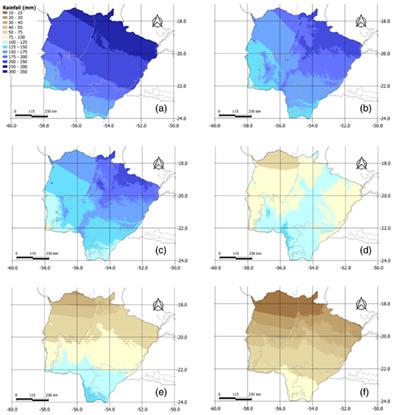当前位置:
X-MOL 学术
›
Int. J. Climatol.
›
论文详情
Our official English website, www.x-mol.net, welcomes your
feedback! (Note: you will need to create a separate account there.)
Analysis of monthly and annual rainfall variability using linear models in the state of Mato Grosso do Sul, Midwest of Brazil
International Journal of Climatology ( IF 3.5 ) Pub Date : 2020-09-30 , DOI: 10.1002/joc.6857 Marcel Carvalho Abreu 1 , Amaury Souza 2 , Gustavo Bastos Lyra 1 , Ivana Pobocikova 3 , Roberto Avelino Cecílio 4
International Journal of Climatology ( IF 3.5 ) Pub Date : 2020-09-30 , DOI: 10.1002/joc.6857 Marcel Carvalho Abreu 1 , Amaury Souza 2 , Gustavo Bastos Lyra 1 , Ivana Pobocikova 3 , Roberto Avelino Cecílio 4
Affiliation

|
This study aims at fitting polynomial models based on latitude, longitude and altitude coordinates to estimate the monthly and annual mean rainfall in Mato Grosso do Sul state, Midwest region of Brazil. Furthermore, its target is to verify whether hydrologically similar regions provide statistical improvement in the regression fit for rainfall estimation. To create the monthly and annual rainfall for 32 rain gauge stations, there were used at least 15 years long data records for analysis with a percentage of gaps at most 10%. Generally, the monthly and annual rainfall models present suitable statistical validation coefficients. The number of predictor variables enhances the performance of the regression method when estimating monthly and annual rainfall. Fitting regressions in hydrologically similar groups through cluster analysis tends to increase regression performance; however, the limited number of rain gauge stations in Brazil makes this technique difficult to apply because the number of parameters of the regression models may be greater than the number of rain gauge stations in the cluster. The first degree polynomial regression proved to be the most adequate to represent the mean monthly and annual rainfall because of the equivalence between observed and predicted values of rainfall and because of the statistical analysis. Fitting polynomial models presents suitable method for practical applications, forming an important tool for environmental management in the Mato Grasso do Sul State.
中文翻译:

使用线性模型对巴西中西部马托格罗索州南部的月度和年度降雨量变化进行分析
这项研究旨在基于纬度,经度和海拔坐标拟合多项式模型,以估计巴西中西部地区南马托格罗索州的月平均降雨量和年平均降雨量。此外,其目标是验证水文上相似的地区是否在降雨拟合的回归拟合中提供了统计上的改进。为了创建32个雨量计站的月度和年度降雨量,使用了至少15年的数据记录进行分析,其差距百分比最多为10%。通常,月度和年度降雨模型会提供合适的统计验证系数。当估计每月和每年的降雨量时,预测变量的数量可以提高回归方法的性能。通过聚类分析将水文相似组的回归拟合可以提高回归性能。但是,由于巴西雨量站的数量有限,使得该技术难以应用,因为回归模型的参数数量可能大于集群中雨量站的数量。事实证明,由于观测值与预报值的相等以及统计分析的结果,一级多项式回归最能代表月平均降雨量和年降雨量。拟合多项式模型为实际应用提供了合适的方法,形成了南马托格拉索州的环境管理的重要工具。巴西有限的雨量计站数量使该技术难以应用,因为回归模型的参数数量可能大于集群中的雨量计站数量。事实证明,由于观测值与预报值的相等以及统计分析的结果,一级多项式回归最能代表月平均降雨量和年降雨量。拟合多项式模型为实际应用提供了合适的方法,形成了南马托格拉索州的环境管理的重要工具。巴西有限的雨量计站数量使该技术难以应用,因为回归模型的参数数量可能大于集群中的雨量计站数量。事实证明,由于观测值与预报值的相等以及统计分析的结果,一级多项式回归最能代表月平均降雨量和年降雨量。拟合多项式模型为实际应用提供了合适的方法,形成了南马托格拉索州的环境管理的重要工具。事实证明,由于观测值与预报值的相等以及统计分析的结果,一级多项式回归最能代表月平均降雨量和年降雨量。拟合多项式模型为实际应用提供了合适的方法,形成了南马托格拉索州的环境管理的重要工具。事实证明,由于观测值与预报值的相等以及统计分析的结果,一级多项式回归最能代表月平均降雨量和年降雨量。拟合多项式模型为实际应用提供了合适的方法,形成了南马托格拉索州的环境管理的重要工具。
更新日期:2020-09-30
中文翻译:

使用线性模型对巴西中西部马托格罗索州南部的月度和年度降雨量变化进行分析
这项研究旨在基于纬度,经度和海拔坐标拟合多项式模型,以估计巴西中西部地区南马托格罗索州的月平均降雨量和年平均降雨量。此外,其目标是验证水文上相似的地区是否在降雨拟合的回归拟合中提供了统计上的改进。为了创建32个雨量计站的月度和年度降雨量,使用了至少15年的数据记录进行分析,其差距百分比最多为10%。通常,月度和年度降雨模型会提供合适的统计验证系数。当估计每月和每年的降雨量时,预测变量的数量可以提高回归方法的性能。通过聚类分析将水文相似组的回归拟合可以提高回归性能。但是,由于巴西雨量站的数量有限,使得该技术难以应用,因为回归模型的参数数量可能大于集群中雨量站的数量。事实证明,由于观测值与预报值的相等以及统计分析的结果,一级多项式回归最能代表月平均降雨量和年降雨量。拟合多项式模型为实际应用提供了合适的方法,形成了南马托格拉索州的环境管理的重要工具。巴西有限的雨量计站数量使该技术难以应用,因为回归模型的参数数量可能大于集群中的雨量计站数量。事实证明,由于观测值与预报值的相等以及统计分析的结果,一级多项式回归最能代表月平均降雨量和年降雨量。拟合多项式模型为实际应用提供了合适的方法,形成了南马托格拉索州的环境管理的重要工具。巴西有限的雨量计站数量使该技术难以应用,因为回归模型的参数数量可能大于集群中的雨量计站数量。事实证明,由于观测值与预报值的相等以及统计分析的结果,一级多项式回归最能代表月平均降雨量和年降雨量。拟合多项式模型为实际应用提供了合适的方法,形成了南马托格拉索州的环境管理的重要工具。事实证明,由于观测值与预报值的相等以及统计分析的结果,一级多项式回归最能代表月平均降雨量和年降雨量。拟合多项式模型为实际应用提供了合适的方法,形成了南马托格拉索州的环境管理的重要工具。事实证明,由于观测值与预报值的相等以及统计分析的结果,一级多项式回归最能代表月平均降雨量和年降雨量。拟合多项式模型为实际应用提供了合适的方法,形成了南马托格拉索州的环境管理的重要工具。











































 京公网安备 11010802027423号
京公网安备 11010802027423号